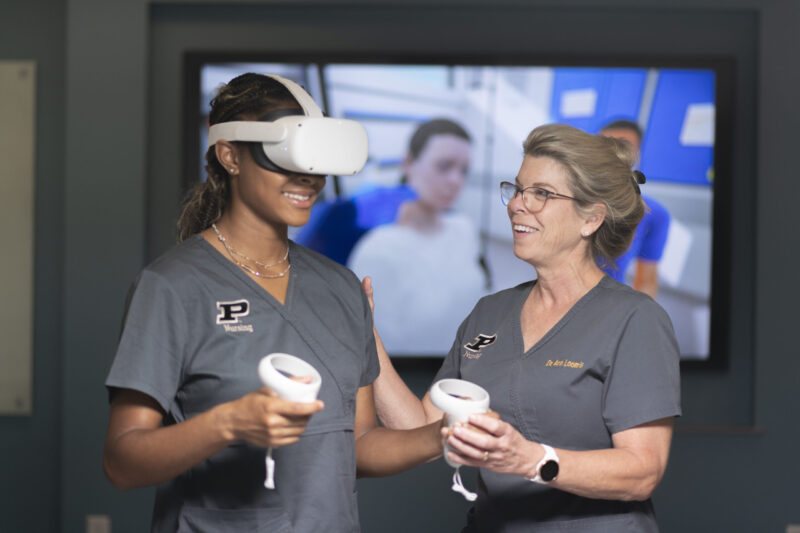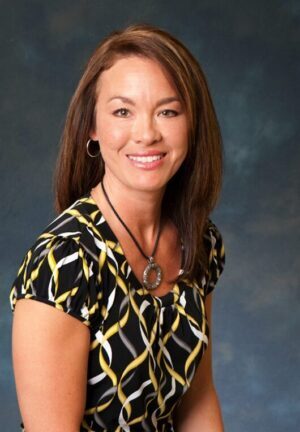Virtual reality opens new world of education for Purdue School of Nursing students
Written By: Rebecca Hoffa, rhoffa@purdue.edu

Purdue clinical associate professor Ann Loomis coaches a nursing student as they use the VR technology in the NUR 42001 (Transition to Professional Nursing Practice) course.(Purdue Marketing and Communications/John Underwood)
Beeping medical equipment, ringing phones, rushing feet — the sounds of a hospital surround a Purdue University School of Nursing (NUR) student as they tend to their patient and are paged to care for another. The health care decisions are theirs alone to make as they look at the clock to manage their time. Forty minutes have passed. They remove the Oculus headset from their eyes and prepare to debrief their experiences with their faculty instructor.
As part of a research collaboration led by the University of Minnesota’s School of Nursing, virtual reality (VR) headsets are being embedded into Purdue’s nursing curriculum through the NUR 42001 (Transition to Professional Nursing Practice) course, which is taught by a team including Ann Loomis, clinical associate professor of nursing.
In addition to traditional simulations where students practice scenarios on a manikin in the Nursing Center for Education and Simulation, students in the course will rotate through five VR scenarios throughout the semester. These scenarios will progressively increase students’ patient loads and the complexity of the patients’ medical conditions. The life-like rendering immerses students in the sights, sounds and processes of a hospital to make the transition to the nursing profession easier and to better prepare students for their future careers.
“It is very hard to take a novice nurse, throw them in to take care of multiple patients, and just say ‘Here, figure out who you are going to see first and why,’” Loomis said. “Realistically, how do you offer that in school? You don’t want things to go badly for the student or the patient.”
Cynthia Bradley, who is primary investigator of the VR research and assistant professor of nursing at the University of Minnesota, said she chose Purdue as one of the universities to involve in the research project because of its School of Nursing’s size and reputation. The study, which was funded by the American Nurses Foundation, aims to test the implementation of these VR simulations in nursing curriculum using Big Ten universities, but the research team plans to later make the opportunity available to any college or university that may not have the resources to have their own simulation centers or preceptor programs.

Cynthia Bradley(Photo provided)
“Purdue is probably more innovative than some schools, with the schools of engineering and all that they do,” Bradley said. “Purdue just seemed like a really great fit of trying out some new technology, and it seemed that the student population in the School of Nursing would be willing to try this and eager to see how it worked.”
Loomis noted this implementation of VR technology could be just the beginning of new ways of thinking about preparing nurses for practice. As part of the College of Health and Human Sciences (HHS), nursing faculty engage in a variety of interdisciplinary research projects to improve nursing practice and implement novel approaches to nurse education.
“The School of Nursing is more than a typical nursing school because it is positioned among nine departments and schools focused on enhancing human health and well-being,” said Marion K. Underwood, HHS dean. “This research collaboration to improve nursing education through virtual reality technology is just one example of how our nursing faculty and curriculum work hard to stay on the cutting edge of innovation.”
Loomis began testing the VR headsets in the spring alongside senior nursing student volunteers, working through any glitches to set up the fall semester for success. One of the students reached out to Loomis after she graduated in May and took the state board exam, noting that one of the VR scenarios she participated in appeared on her test, and as a result, she aced that component of the exam. For Loomis, this was a big confidence booster in the work that she — in collaboration with Bradley’s team — is doing.
“This is exactly what we’re after — that transition to practice,” Loomis said. “Here is real life, and we may not be able to bring it to you live, but we will do it through the VR headset, and that’s something we can continue to change, develop and improve on.”
Currently, the number of nurses who leave the nursing profession within three years is staggering, Bradley explained. Because of this, she and her research team hope to help ensure nurses are more prepared for and happier in their careers. The researchers will measure results over the course of the academic year by comparing evaluations generated by the VR software with evaluations in students’ traditional simulations to see how overall competencies compare. They also plan to ask students to share an evaluation tool with their employers upon graduation to see how the VR influenced their transition to practice.
“The care environment is just so complex, and so being able to prepare a student in their bachelor’s degree for this lifetime career is a really big job,” Bradley said. “We’re hoping that through introducing more experiences with complexity, interruptions and distractions that are very common in a hospital situation, they understand a little more of what they’re actually getting into so they’re mentally more prepared for some of those challenges. Then, looking long-term, we’re hoping that we won’t see the attrition in nursing that we’re seeing now.”
As Loomis begins implementing the technology in her class this semester, she said she is excited to see the difference it makes in her students’ learning outcomes.
“Knowing the worth of this technology and the takeaways these students are going to have — the value behind this is huge,” Loomis said. “That’s what I’m excited for. It’s just like one student taking the time to email and say, ‘I aced that section on the national exam because I took care of that patient.’ It was VR, but that’s how real it is. You are making those judgment calls, and you better know this information, or it’s going to impact the next choice you make, and again, that’s real world. These are human lives. It’s as close to real-world experience as we can get.”